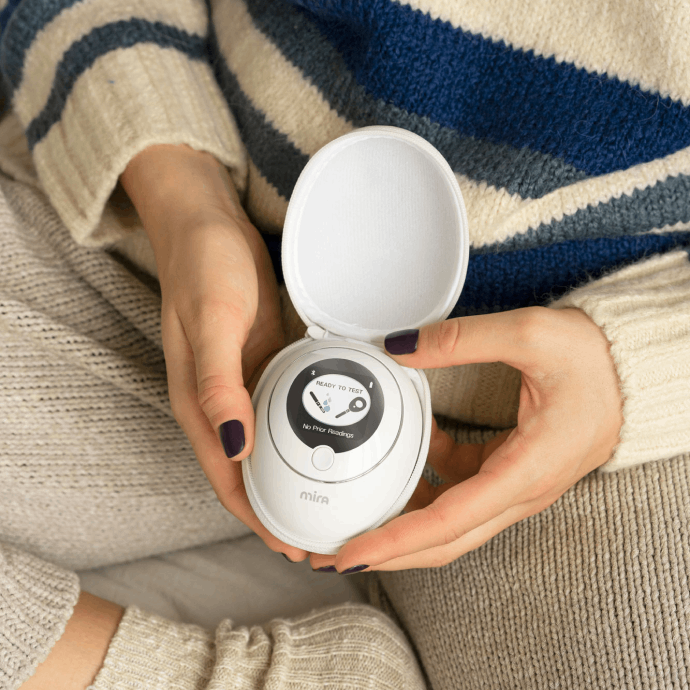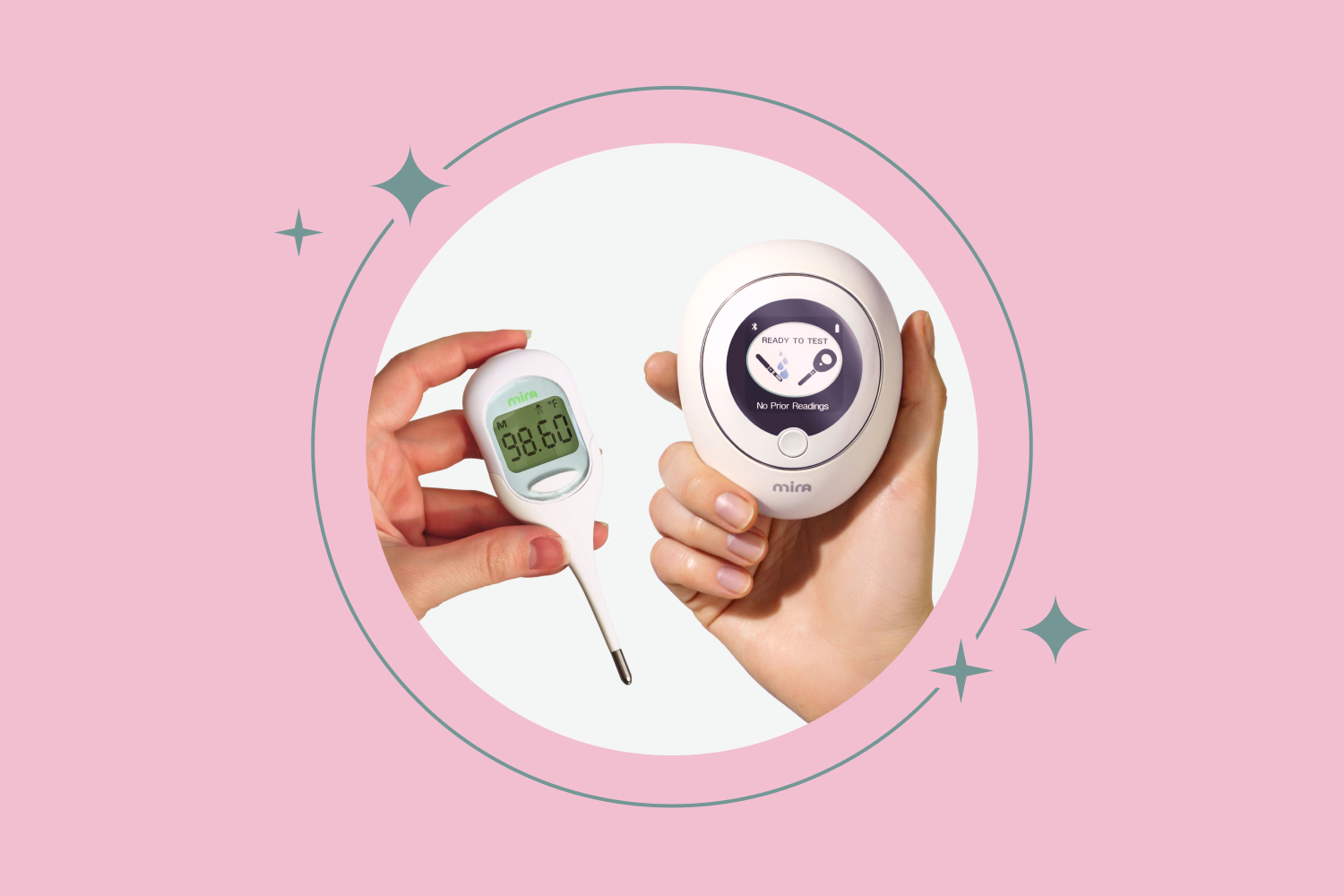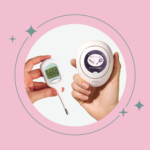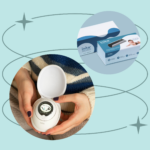Mira VS ClearBlue: What’s the Best Fertility Monitor?

Testing your hormones in order to plan a pregnancy has never been more accessible. However, with all the options available, choosing the right one for you and your individual cycle can be overwhelming.
To help, here is a closer look at two popular hormone testing options for those trying to conceive (TTC): the Mira Max Starter Kit and the Clearblue® Fertility Monitor. We’ll cover everything you need to know about what they do, how to use them, and the pros and cons of each.
Let’s go!
What is Mira’s Starter Kit?
Mira is a health tech company offering at-home hormone tests, prenatal multivitamins, online courses, and other products.
Mira’s Starter Kit is their flagship product.
Shortly: it’s a palm-sized at-home lab for your hormones. The FSA/HSA-qualified testing system measures certain fertility hormones’ metabolites in urine.

The attractive monitor is easy and intuitive. But inside the little ‘egg,’ there is a complicated technology called immunochromatography with fluorescence labeling. Similar fluorescence-based tech is often used at real fertility labs. The labs allow Mira to provide you with real numeric hormone scores in just 21 minutes.
Once measured, the results are tracked and analyzed using the Mira AI, which is trained on 4M+ hormone data points. As a result, the user gets a personalized hormonal chart, scores, and interpretations with 99% accuracy.
What’s included?
The Mira Max Starter Kit includes all of the following:
- Mira Analyzer
- Deluxe Mira Carrying Pouch
- Charging Cable
- 10 or 20 Single-use Test Wands which measure Estradiol Metabolite (E3G), Luteinizing Hormone (LH), and Pregnanediol-3-Glucuronide (PdG)
- 1 Silicone Cup
- Quickstart Guide
Users must also download the free Mira App on their smartphone or tablet to use the system.

What does it measure?
The test wands included in the Fertility Plus Starter Kit measure the following:
- LH (Luteinizing Hormone) to predict your ovulation accurately.
- E3G (Estradiol Metabolite) to identify your full 6-day fertile window.
- PdG (Pregnanediol-3-Glucuronide) to confirm ovulation happened during an exact menstrual cycle.
It is also possible to measure FSH (Follicle Stimulating Hormone) with Mira to check your fertility health status and evaluate how far you are from menopause. Mira’s FSH testing wands are not included in the Starter Kit. However, they can be purchased separately with the (Ovum Wands) or in the Bundle.
Who is it for?
Anyone with ovaries can use Mira to learn more about their reproductive health.
Mira is particularly suitable for individuals and couples who are:
- Planning a pregnancy.
- Struggling to become pregnant.
- Struggling to balance hormones due to lifestyle factors or medical conditions – such as polycystic ovary syndrome (PCOS).
- Looking to monitor reproductive hormones during perimenopause.
How does testing work?
Testing with Mira is simple. All you have to do is:
- Collect a urine sample.
- Dip the test wand into the urine sample for 20 seconds.
- Insert the wand into the Mira Analyzer.
- Open the Mira App to view your real-time numeric LH, E3G, or PdG levels. You also can consider your hormone curve, cycle calendar, and cycle insights.
Note: Testing at least 10-20 times per cycle is recommended for the most accurate results.

What can you do with your results?
If you are actively trying to conceive (TTC), you can use your results to identify your ovulation day and estimated 6-day fertile window. You can also confirm whether or not ovulation occurred.
Those approaching perimenopause or menopause can use Mira to see how their hormone patterns fluctuate and change with age.
What are the costs?
The Mira Max Starter Kit costs $229 for the 10-wands version and $249 for the 20-wands version.
This entire kit should get you through your first cycle of using Mira. After that, you will not need to purchase the analyzer again but you will need to buy more test wands to continue testing.
As of now, there are five options of the Wands (x 20 in the box) available for the Mira analyzer:
- Mira Fertility Plus Wands track LH, and E3G, and cost $64.99 for 20 wands.
- Mira Fertility Max Wands track LH, E3G, and PdG and cost $89 for 20 wands.
- Mira Fertility Confirm Wands track PdG and cost $67.99 for 20 wands.
- Mira Ovum Wands track FSH and cost $45 for 20 wands.
- You can save up to 10% by subscribing to a monthly or bi-monthly subscription.
Also, you can subscribe to Mira to get a delightful welcome discount.
What is Clearblue Fertility Monitor?
Clearblue is a reproductive health tech company specializing in helping individuals estimate ovulation and test for pregnancy.
The Clearblue® Fertility Monitor is their most advanced solution for predicting ovulation. Currently, it tests and tracks two key fertility hormones including luteinizing hormone (LH) and estradiol metabolite (E3G).
What’s included?
The Clearblue® Fertility Monitor includes
- 1X touch-screen monitor system
- Instructions for use
Test sticks typically must be purchased separately – see product instructions for more details.
What does it measure?
The Clearblue® Fertility Monitor tests for luteinizing hormone (LH) and estradiol metabolite (E3G).
Who is it for?
The Clearblue® Fertility Monitor is suitable for individuals and couples who are:
- Actively planning a pregnancy
- Struggling to have sex at the right time each cycle
How does testing work?
Testing with the Clearblue® Fertility Monitor requires following the steps below:
- Collect a urine sample using ‘first-morning urine’
- Dip the test stick into the urine sample for 20 seconds
- Insert the test stick into the monitor (make sure the monitor is switched on)
- Wait up to 5 minutes to receive your results
Note: According to the Clearblue® Fertility Monitor user manual, test sticks must be used in sets of 10 from the same pack in order to ensure reliability. In some cases, a further 10 test sticks may be required in the same cycle.
What can you do with your results?
After testing, the Clearblue® Fertility Monitor will provide you with qualitative results of either “Low Fertility”, “High Fertility”, or “Peak Fertility”.
If your fertility is labeled “High” or “Peak”, this indicates that you should have sex with your partner to maximize your chances of conception.
What are the costs?
The current price of a Clearblue® Fertility Monitor on Amazon is $118.67. The additional test sticks are also available at around $40.00 for a pack of 30 sticks. However, pricing can vary depending on your region.
Mira vs. Clearblue
Mira: Pros & Cons
The primary benefit of Mira is that it can track more hormones compared to Clearblue. In addition to LH and E3G, Mira can also track PdG (Pregnanediol-3-Glucuronide) for increased accuracy of fertile window detection. Mira also has additional wands available that can measure FSH (follicle-stimulating hormone), which provides insight into fertility status ahead of menopause.
Another key benefit of Mira is its high level of accuracy. A recent research study found that Mira users missed fewer LH peaks compared to Clearblue users. This was due to Mira’s quantitative (i.e. numerical) approach to hormone measurement compared to the Clearblue® Fertility Monitor’s qualitative approach.
In the short term, Mira’s main downside is its higher cost. However, because the Clearblue® Fertility Monitor is so limited in what it can test, Mira would be a more practical investment for the long term.
Clearblue: Pros & Cons
The primary benefit of using the Clearblue® Fertility Monitor compared to Mira is its lower start-up cost. On average, Clearblue’s wands are also slightly cheaper compared to Mira’s wands.
For some users, another benefit of the Clearblue® Fertility Monitor is its simplistic results. Even though Mira’s numeric results are more accurate and personalized, a simple “Low”, “High”, or “Peak” fertility indicator is enough information to support certain individuals with planning a pregnancy.
The main downside of the Clearblue® Fertility Monitor is its general inflexibility in terms of hormones available for testing and usability. Again, the Clearblue® Fertility Monitor can only measure LH and E3G, and it cannot measure PdG.
Beyond that, many users have mentioned that the Clearblue® Fertility Monitor has inflexible testing times and data input capabilities. This can cause delays and make the product less attractive for individuals with longer, shorter, or irregular cycles.
Final Thoughts
If you have a regular cycle that falls within 21 to 35 days, then the Clearblue® Fertility Monitor may be a more cost-effective choice in the short term. This is especially true if you prefer to receive more basic results about your fertility, and if you already track other elements of fertility such as your basal body temperature (BBT) and/or cervical mucus.
However, if you:
- Know that your cycle is irregular
- Have a hormonal condition such as PCOS
- Want a more complete, advanced picture of your cycle and fertility
- Want to invest in your reproductive health for the long term
Then the Mira Max Starter Kit is a better choice for you due to its lab-grade accuracy, numeric test results, and a broader range of hormone tests available.

Mira’s Editorial Process
All content produced by Mira meets stringent editorial standards, ensuring excellence and accuracy in language and medical precision. Every piece undergoes thorough fact-checking and review by qualified professionals. Check out our full editorial process to learn more.










